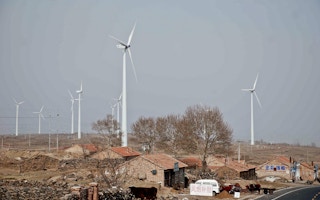Achieving the ambitious global Sustainable Development Goals (SDGs) – which include ending poverty, improving global health, ensuring universal education, and mitigating climate change by 2030 – will cost a lot of money.
To continue reading, subscribe to Eco‑Business.
There's something for everyone. We offer a range of subscription plans.
- Access our stories and receive our Insights Weekly newsletter with the free EB Member plan.
- Unlock unlimited access to our content and archive with EB Circle.
- Publish your content with EB Premium.
The total will be far more than governments can make available, and the gap cannot be closed by official development assistance, now at $132 billion per year. The private sector, as well as updated financial markets, will be essential.
Until recently, international organizations and governments had relatively well-defined roles in the global development and sustainability agenda, whereas the private sector’s participation in the process was often viewed through the lens of its contributions to economic growth, job creation, and tax revenue.
That must now change, with the private sector taking on a broader, more integrated role in the development agenda.
The private sector can become a financier, shifting trillions of dollars of capital toward developing economies. And it can play an important role as an implementer, translating profits into sustained economic growth, social inclusion, and environmental protection.
The principles underpinning such measures are anchored in SDG target 12.6, which encourages “companies, especially large and transnational companies, to adopt sustainable practices and to integrate sustainability information into their reporting cycle.”
Financial and asset-management institutions can provide positive incentives to such companies – those that incorporate sustainability, long-term thinking, and environmental, social, and governance (ESG) performance criteria in core business models – by allocating assets accordingly. Such a move would go a long way toward promoting long-term progress on the SDGs.
Fortunately, many companies already fit this description. A 2016 survey of CEOs, conducted by the United Nations Global Compact and Accenture showed that many business leaders already view solving “societal challenges as a core element in the search for competitive advantage.”
And almost half of all CEOs surveyed believe that “business will be the single most important actor in delivering the SDGs.”
According to a recent report published by Moody’s, interest in investments relating to climate change and sustainable development by institutional investors has grown rapidly in recent years. Now, institutional investors with long histories of ESG investments, such as the California Public Employees’ Retirement System (CalPERS), are being joined by a growing number of their peers.
Some are even opting to divest from any company with exposure to industries or business practices that present sustainability challenges.
This trend toward sustainable investment will undoubtedly accelerate. But, even without the agreement, the appeal of such investments stands: evidence indicates that integration of ESG considerations – when implemented intelligently and measured and reported transparently – could help investments outperform expectations, for both companies and investors.
Add to that financial-market incentives, and huge amounts of capital could be attracted to ESG investments.
Nonetheless, significant challenges remain, including uncertain performance expectations and evolving disclosure regimes. Despite innovation in the financial products channeling ESG investment, the supply of ESG instruments, such as green bonds, remains insufficient.
Another challenge relates to data. Good data on ESG investment are indispensable, as they enable investors and companies to determine whether their outlays in this area will promote or impede the achievement of the SDGs.
To this end, we need to develop a robust, transparent reporting framework that allows companies to report on financial and non-financial performance. That framework must also support the private sector and investors in their effort to combine profit maximization with the pursuit of long-term economic, social, and environmental objectives.
“
The private sector can become a financier, shifting trillions of dollars of capital toward developing economies. And it can play an important role as an implementer, translating profits into sustained economic growth, social inclusion, and environmental protection.
Integrated corporate reporting and disclosure of material ESG information can facilitate the creation of an efficient financial system that advances sustainable economic growth, while supporting achievement of the SDGs.
The development of such an integrated reporting framework currently is being led by a few national and international organizations, such as the Global Reporting Initiative (GRI), the Sustainability Accounting Standards Board (SASB), and the International Integrated Reporting Council (IIRC).
Their main objectives are to enable companies and organizations to set sustainability targets and key performance indicators; to monitor, prepare, and disclose comparative data measuring their economic and ESG performance; and to integrate sustainable production and consumption practices in company business strategies and models.
Global awareness of this topic is growing. Recently, Mark Carney, Governor of the Bank of England and Chairman of the G20’s Financial Stability Board, and Michael Bloomberg, a former New York City mayor and CEO of Bloomberg LP, issued an announcement regarding market data on climate.
Given the magnitude of the task, however, it is important also to ensure effective coordination and harmonization of these efforts with the relevant standard-setters, regulators, and professional organizations.
The US Securities and Exchange Commission, for one, is already discussing these issues, as it analyzes options to respond to investor and business needs regarding ESG.
New ESG reporting frameworks can help to attract billions of dollars from institutional investors to support the effort to achieve the SDGs. But that is only one example of how the public and private sectors can work together to identify opportunities to advance the SDGs.
If we take advantage of these possibilities, public-private cooperation can enable millions of people to lift themselves out of poverty and help to build a more peaceful, prosperous, and secure world.
Mahmoud Mohieldin is the World Bank Group’s Senior Vice President of the 2030 Development Agenda, UN Relations, and Partnerships. Svetlana Klimenko is Lead Financial Management Specialist at the World Bank Group.
Copyright: Project Syndicate, 2017.
www.project-syndicate.org











